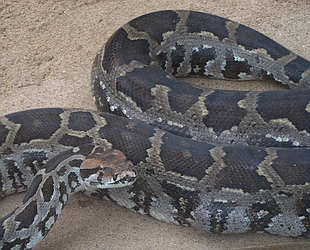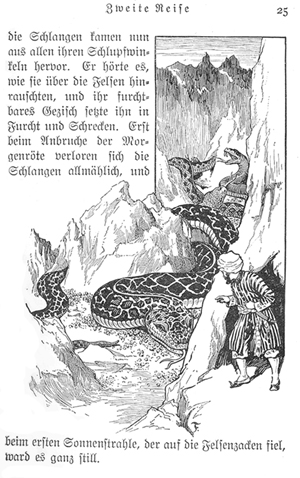
August 15, 2006

The ultimate snake on a plain, The Great Serpent Mound in Ohio may represent a giant snake swallowing an egg.
Accounts of giant snakes have circulated throughout the United States, across the plains, into the forests of Middle America, and from coast to coast. Reports from the area around Bridgewater, Massachusetts, tell of CCC workers in the 1930s encountering huge coiled serpents along the pathways through the Hockomock Swamp. From Hastings, Michigan, comes tales of the twenty-foot-long Carter’s Snake, so named because it was always seen near Carter’s Lake. Near another lake, Reynold’s Lake in Kentucky, local people began to take their hogs inside for fear that their giant snake would devour their livestock after it got its fill of frogs. The era of a snake as “large as a stovepipe” is gone only because nobody uses stovepipes any longer, but the reports of giant snakes continue.
One of the most famous giant snake sighting series was that of the “Peninsula Python.”
In the summer of 1944, a huge snake known as the Peninsula Python caused excitement along the Cuyahoga River in the wooded valley between Akron and Cleveland, Ohio. The creature first appeared on June 8, 1944 when Clarence Mitchell saw it sliding across his corn field. The Peninsula Python left a track the width of an automobile tire, and Mitchell reported the creature to be about 18 feet in length. Two days later, Paul and John Szalay reported a similar track in their fields, and two more days later, Mrs. Roy Vaughn called out the fire department when the giant reptile attacked her hen house. The snake had climbed the fence to her chicken coop and devoured a chicken.
Now that the snake was accepted as fact, theories abounded as to where it had come from. Two years earlier, a carnival truck had supposedly smashed up in a cemetery in the valley and it was speculated that the python might have escaped from this wreck. As I have discovered many times before in my investigations of “circus train wrecks” as the source of any given mystery animal report, the story could never fully be tracked down.

The Indian rock python, a subspecies of the Burmese, is well within the range of how big the the Peninsula Python seems to have appeared.
The Cleveland and Columbus Zoos offered rewards for the live capture of the Peninsula Python, and the news services began to carry the story, which aroused overseas interest from servicemen whose families lived in the valley.
On Sunday, June 25th, the sirens blasted to report the creature had been sighted near Kelly Hill. The town emptied as countless residents headed off to the hill in search of the Python. The hunters trampled through tangled thorn bush and burrs only to learn later that it was a false alarm.
Two days later, on June 27th, the snake leaped down out of a dead willow and frightened Mrs. Pauline Hopko. It so frightened her milk cows that they broke their halters and ran off across the fields, while her dogs cowered under Mrs. Hopko’s skirts. Mrs. Hopko was left holding the milk pail. The snake was also sighted by Bobbie Pollard and some other boys at this time, but it disappeared before the Mayor’s posse arrived on the scene.
After another two days, Mrs. Ralph Griffin saw the snake rear up human-high in the middle of her back yard. Again, the creature avoided the posse. Then Mrs. Katherine Boroutick saw it in her back yard; it came crashing down out of her butternut tree when she was out by the river throwing out some trash. The posse found broken tree limbs and another track to the riverbed. Professional searchers came into the area and the snake was reported a few more times in the fall. However, hunters said they never got word fast enough to get a shot at the snake. By first frost, residents waited for the buzzards to find a huge carcass of a snake dead of the cold, but the Peninsula Python was never sighted again, dead or alive.
The above was taken from Mysterious America, copyright Loren Coleman.

Tales of Giant Snakes are found in old folklore from many lands, even America.
Update
Readers from part one of this blog (above) have emailed and commented that you wanted to see other well-known images regarding giant snakes. Therefore, please click on Snakes on Plains – Part Deux
About Loren Coleman
Loren Coleman is one of the world’s leading cryptozoologists, some say “the” leading living cryptozoologist. Certainly, he is acknowledged as the current living American researcher and writer who has most popularized cryptozoology in the late 20th and early 21st centuries.
Starting his fieldwork and investigations in 1960, after traveling and trekking extensively in pursuit of cryptozoological mysteries, Coleman began writing to share his experiences in 1969. An honorary member of Ivan T. Sanderson’s Society for the Investigation of the Unexplained in the 1970s, Coleman has been bestowed with similar honorary memberships of the North Idaho College Cryptozoology Club in 1983, and in subsequent years, that of the British Columbia Scientific Cryptozoology Club, CryptoSafari International, and other international organizations. He was also a Life Member and Benefactor of the International Society of Cryptozoology (now-defunct).
Loren Coleman’s daily blog, as a member of the Cryptomundo Team, served as an ongoing avenue of communication for the ever-growing body of cryptozoo news from 2005 through 2013. He returned as an infrequent contributor beginning Halloween week of 2015.
Coleman is the founder in 2003, and current director of the International Cryptozoology Museum in Portland, Maine.
Filed under Cryptotourism, CryptoZoo News, Cryptozoologists, Cryptozoology, Eyewitness Accounts